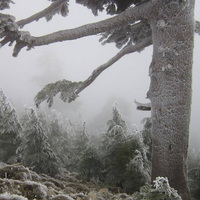Research Interests:
Pour mieux comprendre l'impact des facteurs climatiques et l'influence de la diversité des habitats sur le dépérissement des cédraies des Aurès, une approche dendrochronologique basée sur la relation cerne-climat a été adoptée et... more
Pour mieux comprendre l'impact des facteurs climatiques et l'influence de la diversité des habitats sur le dépérissement des cédraies des Aurès, une approche dendrochronologique basée sur la relation cerne-climat a été adoptée et appliquée à six stations, réparties sur deux cédraies méridionales, du Belezma et du Chélia (Atlas saharien), distantes de 60 km et impactées par différentes perturbations climatiques. Pour les deux sites étudiés, un sondage de 120 arbres a été réalisé, permettant d’extraire au total 240 carottes. Une chronologie maîtresse a été établie pour chaque station et une série moyenne de données a été élaborée pour chaque site. Les chronologies obtenues ont été standardisées afin d’atténuer les effets et les tendances non liées à la variation climatique. Puis, les chronologies résiduelles ont été utilisées pour appréhender la relation cerne-climat. Les résultats obtenus montrent une hétérogénéité de la réponse du cèdre de l’Atlas au sein des deux massifs. L...
Research Interests:
Le but du travail consistait a caracteriser les proprietes physiques du bois de Quercus canariensis (Willd.) et de rendre compte de ses qualifications. L'etude a ete realisee dans une partie de la foret domaniale des Ait Ghobri,... more
Le but du travail consistait a caracteriser les proprietes physiques du bois de Quercus canariensis (Willd.) et de rendre compte de ses qualifications. L'etude a ete realisee dans une partie de la foret domaniale des Ait Ghobri, situee dans la zone bioclimatique humide a variante temperee. Au total, huit stations ont ete choisies selon la methode d'echantillonnage stratifiee progressive. Les essais physiques ont porte sur un effectif de 576 eprouvettes normalisees, prelevees sur un ensemble de 24 arbres abattus. Le travail montre l'effet de l'arbre sur les proprietes physiques ; les caracteristiques propres a l'arbre jouent un role preponderant dans le determinisme des composantes des retraits. La retractabilite volumetrique totale, le coefficient de retractabilite volumetrique totale et la densite a 12 % d'humidite situent le bois de chene zeen dans la categorie des bois a fort retrait, nerveux a tres nerveux et de mi-lourds a lourds. Les resultats attestent...
Research Interests: Density, Sampling, Wood, Wetland, Forests, and 3 moreBioclimatology, Physical Properties, and Woody plant
This study was conducted in the cedar forests of the Belezma (Aures), Djurdjura (Kabylia) and Theniet El Had (Orania) ranges, which vary widely in altitude as well as bioclimatically. The study was undertaken as part of an overall project... more
This study was conducted in the cedar forests of the Belezma (Aures), Djurdjura (Kabylia) and Theniet El Had (Orania) ranges, which vary widely in altitude as well as bioclimatically. The study was undertaken as part of an overall project on the functioning of Algeria’s cedar forests. The problem addressed was the lack of data on the process of heartwood formation in Atlas cedars, which provides very useful information to improve knowledge on the typology of cedar forests. The aim was firstly to identify changes in heartwood formation over space and time. A total of 485 tree sections and cores from the three cedar forests were analysed. The results shows little variation in the proportions of heartwood from different stations in the same forest. Overall, age has a positive influence on heartwood formation and a negative influence on the proportion of sapwood. Heartwood formation appears to begin earlier in the Theniet El Had and Djurdjura forests (at 14 to 17 years of age) and later...
Research Interests:
Research Interests:
The objectif of this study is to draw a map of quality or health of the river system watershed of Soummam by using standard global biological index (IBGN) of AFNOR (1992) and identify the most degraded sections of the watershed. The... more
The objectif of this study is to draw a map of quality or health of the river system watershed of Soummam by using standard global biological index (IBGN) of AFNOR (1992) and identify the most degraded sections of the watershed. The assessment of the biological quality is based on the general principle according to which each type of natural environment has its own characteristics community of organisms. Any degradation of the natural organisms indicates that some disturbance has occurred. Benthic invertebrate community were sampled on three areas of watershed of Soummam, in a total of 34 stations were sampled between 20m and 1100m of altitude between 2004 and 2010. The environmental quality is good in 5.9% of the stations where the index IBGN values displays 13 and 14, which meant that is not far from the fair quality, since these values are located just to the boundary between good and fair quality. A fair biological quality in 26.5% of stations, a bad quality in 52.9% of stations...
Research Interests:
Activated carbons were developed from Apricot stone, by chemically treating with sulfuric acid. Batch adsorption experiments were performed to find out the effective lead removal at different metal ion concentrations, adsorbent size, and... more
Activated carbons were developed from Apricot stone, by chemically treating with sulfuric acid. Batch adsorption experiments were performed to find out the effective lead removal at different metal ion concentrations, adsorbent size, and dosage. Adsorption of Pb 2+ ion was strongly affected by pH. Apricot stone exhibited the highest lead adsorption capacity at pH 6.0. Isotherms for the adsorption of lead on Apricot stone were evaluated with the Langmuir, Freundlich adsorption isotherm models. The equilibrium data fitted well to the Langmuir and Freundlich isotherm models. Adsorption kinetics data were modeled using the pseudofirst and pseudo-second-order models. The results indicate that the second-order model best describes adsorption kinetic data. The estimated maximum capacities of lead ions adsorbed by Apricot stone activated with sulfuric acid were 21.38 mg g�1 . This high uptake showed Apricot stone activated carbon as among the best adsorbents for Pb(II).
